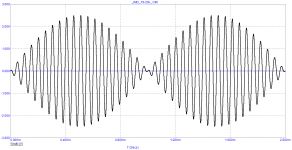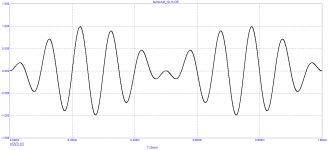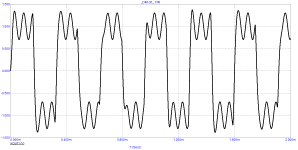OK, why are these signals not suitable for tests?they say you can't suddenly feed the amplifier with a sinusoidal signal from zero and watch how the amplifier reacts to it.
Of course you can. It's just that it is not an audio test because the signal is not an audio signal.
Maybe it will help your understanding if I repeat it a few times?
Of course you can. It's just that it is not an audio test because the signal is not an audio signal.
Jan
Attachments
The disadvantages of the method are as follows:Let me give you a head start: look up 'DIM30 test signal' and the measurements done on the amp response to it. It is a technique used to measure the non-linearity of a device, and it’s designed to be particularly sensitive to distortions produced during transient conditions typical of audio program material.
Jan
1. must be in stock an analog domain Audio Precision 2700 series analyzer. Not everyone can afford it.
2. The DIM measurement provided by the system’s Analog Analyzer is just an approximation of the DIM level specified by IEC 60268-3, because it only considers two of the nine intermodulation components specified in the standard.
I didn't say it's not good but if this method can bring some new type of distortion why can't (shouldn't)DIM30 is a very realistic audio-like signal. Which is what we wanted, no?
we go further with a little bit even more crucial kind of test signal like I draw?
What's the theoretical argue against it? And I don't accept that it's not a typical audio signal
because that's not even the goal. The goal is especially to use a special kind of test signal
to bring up a behvaiour that affects the audio band as well. Why not..?!
No I'm not.You got to be kidding.
Please reply using more conrete arguments I can't reply to that and refine my concept if needed. Thx.
I can completely understand that, but is it a necessary reason to stop there and not look any further?Post 431 has the answer to the 1st part.
The reason is everyone talks about the THD test is because it is simple to do and understand.
Going beyond that takes effort and investment in time and equipment.
Once again: the concept is to use a SPECIAL (not necessarily regular audio band) test signalSo, how many times on a CD record, with 10 tracks, do this situation arise - as you see it?
as a MAGNIFYING glass to bring up something that COULD also affect the normal audio band as well.
The same is true with THD method: we don't listen to either a 1kHz sine wave nor a square wave,
still we found that the distortion based on these checks are (somewhat) correlating with the
total sound quality so they are useful methods.
Why the same can't be true with a faster signal test signal?!
Thanks scott, that's what I meant as a constructive way of posting.20kHz BW may not be quite enough to capture successive transients within certain sounds
Neither we don't know the importance of such a FCD test even so and hopefully it's worth at least a try...
The disadvantages of the method are as follows:
1. must be in stock an analog domain Audio Precision 2700 series analyzer. Not everyone can afford it.
2. The DIM measurement provided by the system’s Analog Analyzer is just an approximation of the DIM level specified by IEC 60268-3, because it only considers two of the nine intermodulation components specified in the standard.
Come on, think! These are NOT disadvantages of the method. The method can be done in various ways with various equipment.
Jan
"So, how many times on a CD record, with 10 tracks, do this situation arise - as you see it?"
Wait now - so the situation that you talk about cant/will not happen on a CD record - or what? How do you see this?
Why test with a signal that cant arise in reality? What does that prove?
I think you need to answer the above questions to have any reasonable creditability.
//
...
Once again: the concept is to use a SPECIAL (not necessarily regular audio band) test signal
as a MAGNIFYING glass to bring up something that COULD also affect the normal audio band as well.
The same is true with THD method: we don't listen to either a 1kHz sine wave nor a square wave,
still we found that the distortion based on these checks are (somewhat) correlating with the
total sound quality so they are useful methods.
Why the same can't be true with a faster signal test signal?!......
Wait now - so the situation that you talk about cant/will not happen on a CD record - or what? How do you see this?
Why test with a signal that cant arise in reality? What does that prove?
I think you need to answer the above questions to have any reasonable creditability.
//
Let's look at your signals for the simulation case, because that's where you see the results.OK, why are these signals not suitable for tests?
The first one is visually appropriate, since it is a common mixture of two sinuses. But the second one is not good, because you put it together with a break in the function and in the middle, where the amplitudes decrease to zero and increase again, you will have a step surge. Show the response of the same amplifier to both of these signals for comparison.
If you're talking about me, you're wrong. My professional activity is not related to audio, for me it is just a hobby.Feverish persistence is one of the telltale signs of those carrying business interest.
Last edited:
Jan, in the microcap it is not a problem to use any test signal, including the DIM-30Come on, think! These are NOT disadvantages of the method. The method can be done in various ways with various equipment.
Jan
Attachments
It will of course but not so remarkably and that's exactly the point.Wait now - so the situation that you talk about cant/will not happen on a CD record - or what?
How do you see this?
Here we try to develop a special test method that emphasizes, amplifies,
magnifies, zooms into a specific behaviour which is there even playing normal
music but it's so subtle (in all the conventional domains) that we have to
"force it out" with a harder drive and condition.
And the basic concept or principle behind all of this is that if you manage
to improve the performance in harder circumstances, it will
affect the performance on easier circumstances as well.
Like using glasses when polishing a car even when you can't spot out some subtle,
minor "errors" with the naked eye on the finish and you just have an overall
impression that it's somehow not perfectly clean.
Because if we can grab some strange behaviour/result with this methodWhy test with a signal that cant arise in reality? What does that prove?
and then improve it during / despite of this extreme condition, after that
we could check how this improvement affected the performance under
normal conditions. I.e. how the amplifier sounds after such a modification...
If somehow it correlates, we're lucky, and that's what this topic is started for.
Cortez, I'm afraid your efforts to organize a constructive discussion in this thread are in vain, there is no one to discuss with. You see that some are just laughing (everything they are capable of) while others are banging their heads against the wall and repeating: "This cannot be because it cannot be"I didn't say it's not good but if this method can bring some new type of distortion why can't (shouldn't)
we go further with a little bit even more crucial kind of test signal like I draw?
What's the theoretical argue against it? And I don't accept that it's not a typical audio signal
because that's not even the goal. The goal is especially to use a special kind of test signal
to bring up a behvaiour that affects the audio band as well. Why not..?!
a specific behaviour which is there even playing normal music
No, it's not, that's the point that is being made but ignored.
...snip...
If somehow it correlates, we're lucky, and that's what this topic is started for.
OK - so it happens on a CD - how often?
0, 10 or several 1000/s
You must have some idea?
Then I musts ask you who are "we"?
The topic started to question the idea of "first cycle distorsion" as something real to begin with. Because a very knowledgeable person, Anders, could not understand what it was all about. Then other also very insightful persons said that this was nothing new and not a "problem".
Then some less educated persons claimed that it must be a problem - that would be you and a few more... but don't try to pretend that people who posts here are on a common journey to some new truth by using "we" - because we aren't.
Rather, as you cant answer my questions about how often the "problem" occurs, it seems that you don't even understand what the "problem" - really logical if one things about it.
//
Last edited:
Maybe it would be better to explain to petr_2009 what kind of claims are expected to be supported by what quality and quantity of supporting evidence.
For example, claims of having a personal opinion about something requires virtually no supporting evidence.
Claims of fact that go against well established knowledge and theory require may require the greatest supporting evidence.
It also may matter to some people how many times a claim is repeated. A claim mentioned once in passing is hardly worth a big, long argument.
There are not written standards for the above issues, they intuitively exist in peoples minds. Everyone is a bit different, but sometimes a lot of people feel all at once that some threshold has been passed where claims don't have as much supporting evidence as they need.
In addition, 'sound quality' is perceptual term that people often use freely. From a strict scientific perspective it may sometimes matter how sound quality as perceived by humans is measured.
For example, claims of having a personal opinion about something requires virtually no supporting evidence.
Claims of fact that go against well established knowledge and theory require may require the greatest supporting evidence.
It also may matter to some people how many times a claim is repeated. A claim mentioned once in passing is hardly worth a big, long argument.
There are not written standards for the above issues, they intuitively exist in peoples minds. Everyone is a bit different, but sometimes a lot of people feel all at once that some threshold has been passed where claims don't have as much supporting evidence as they need.
In addition, 'sound quality' is perceptual term that people often use freely. From a strict scientific perspective it may sometimes matter how sound quality as perceived by humans is measured.
Last edited:
- Home
- Amplifiers
- Solid State
- First cycle distortion - Graham, what is that?


